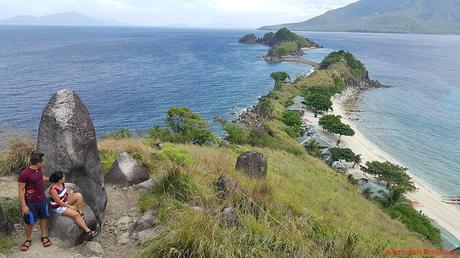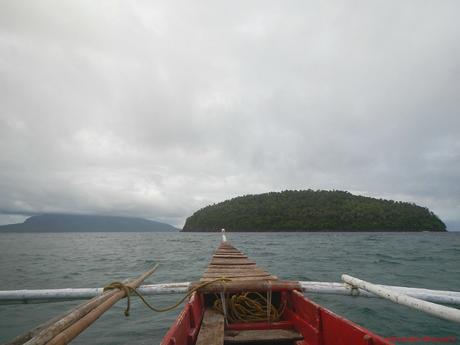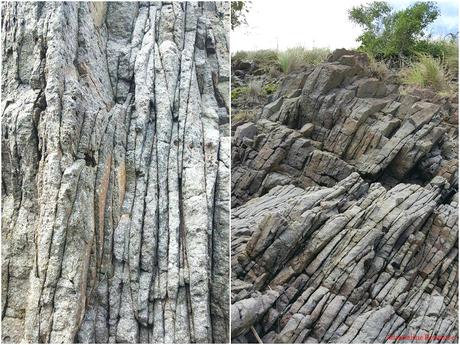
The Philippines has more than 7,100 magnificent islands, each one with its own set of particular features and characteristics worth discovering. The uniqueness of each island, islet, outcropping, or sandbar is one of the things that makes our country so appealing to locals and foreigners alike. We had a chance to visit Sambawan Island, one of the most picturesque islands we’ve ever been to, right off the coast of mainland Biliran.
A visit to Sambawan Island was our reward after successfully accomplishing an awesome canyoning adventure. It was time to relax and simply gaze at the region’s lovely seascapes.
So we woke up early at 5:30 AM so we can pack up, check out, and head to our last destination of this weekend adventure. The gray, cloudy skies and a moderately strong wind got us a bit worried considering that we were going to take a sea journey. Nevertheless, we reached the quiet port of Kawayan without any untoward event after a 15-minute habal-habal ride.

Sir Joni already arranged a pumpboat before we arrived in Biliran. We were supposed to head to Sambawan Island on our first day, but as you remembered in Part 1 of our canyoning adventure, the weather did not cooperate. So we had to reschedule our trip to Sambawan after our canyoning session.

Then off we went! Check out the thick and ominous cloud cover. Right after we left the port, the seas became rough and choppy. While our hearts beat in anxiety, our boatmen were unperturbed and said this was “normal.”

On the way, we passed by uninhabited islets. Well, not entirely uninhabited. With the absence of humans, these virgin islets are homes to dozens of species of birds, mammals, reptiles, and insects.

Moderately high winds resulted in a rough and wet ride reminiscent of our boat ride to Kalanggaman Island in Palompon, Leyte. But after one hour of enduring large waves, we finally saw the rock outcroppings that make up Sambawan Island.
In addition, the spirit of the sea seemed to hear our pleas for good weather because the clouds gradually cleared as we neared the island.

Welcome to beautiful Sambawan Island! Check out their very festive welcome signage. It’s made up of bamboo and bilaos (large, traditional flat winnowing baskets).

(Photo credit: Halourd)
It was still quite early when we reached Sambawan Island, so there were hardly any people there aside from the caretakers, some local fishermen, and a handful of foreigners who spent the night there. Overall, it was the right place and time for some much-needed solitude.
Sambawan Island’s main beach is comprised of fine, white sand and bits of dead, washed-up corals.

We were ravenously hungry since we didn’t have a meal before we left for the island. Sweetie volunteered to cook some hot breakfast of scrambled eggs, sausages, corned beef, and cheese. We paired it off with piping hot coffee.
Freshly cooked, hot breakfast on the beach! Now, that’s what you call a real meal!

After a hearty and satisfying breakfast, we went around the island. Open-air cottages like these are available for rent at affordable rates.

We also chanced upon a bunch of burly men building a classic outrigger pumpboat. This will be used as a vessel to transport tourists to various spectacular dive sites around Sambawan Island. Oh, yes, Sambawan Island is a diver’s destination!
Too bad we didn’t have enough money for a dive or two. But since Sambawan Island is just a day trip from our place in Cebu, then we can always schedule a diving adventure anytime.

But for us, the most interesting—and heart-lifting—thing about Sambawan Island is that it’s a sea turtles’ nesting ground! In fact, a large patch of the beach was fenced off by the island’s stewards to protect a nest.
After some time in incubation, baby turtles will emerge from the nest and scramble madly to the sea. Returning to the sea is a life-and-death situation for them as they become a dinner buffet for frigate birds, mammals, and fish. In the wild, only one out of a hundred survives.

Here’s another protected turtle’s nest. Thankfully, because Sabawan is inhabited and there are human guardians, frigate birds and large predatory fish are absent. Thus, most of the baby turtles survive and have a bigger chance to become healthy adults.

Right behind the shady tree where we ate our breakfast was a series of concrete steps that lead up to an imposing hill. At the other side is this lovely view that resembles a visit of sea cliffs in Nova Scotia.

At the end of the concrete steps is a crude viewing tower made of concrete, nipa, wood, and bamboo. We could already see Halourd having the time of his life taking photos with his phone.

Now, isn’t that a stunning view? I wish I was a master poet so I can fully describe how the gentle curve of the sandy beach, the streaks of blue and aquamarine of the surrounding water, the rich green grasslands, the irregular shapes of rocks, and the magnificent sky all blend together in one harmonious vista.
The big island nearby is the volcanic Maripipi Island. It’s centerpiece is the 924-meter, forest-covered Maripipi Volcano which is actually a potentially active volcano. The town of Maripipi is located at the bottom of the slope.

Facing Biliran Island is this small, grass-covered rocky peninsula. Those who want to set up a camp or go to a quieter part of the island can head down here.

The team quietly enjoyed the scenery while taking shelter from a strong wind gust. Of course, no rest session is complete without a selfie.

(Photo credit: Halourd)
We decided to explore the peninsula’s beach, which could be accessed via a man-made boardwalk affixed to the side of the hill.

Along the way, we came across huge barnacle-encrusted rocks below us. Barnacles are actually arthropods that are somewhat related to crabs and lobsters. They attach themselves to erosive surfaces such as rocks, wood, concrete, and steel hulls.

Check out those amazing rock formations, which is eerily similar to the stone cliffs of Mabua Pebble Beach in Surigao del Norte. They reminded us of our first backpacking trip as Team Sweetie.

(Photo credit: Halourd)
More strange rock formations line up the short cliff. They seem to be seamlessly arranged in layers.

(Photo credit: Halourd)
Carefully laid bricks? No, they’re perfectly layered rocks, sculpted by the wind and sea.

(Photo credit: Halourd)
The shore on this side of the island is made up of coarse sand and rocks. Waves, currents, and winds deposit some garbage on the shore. The presence of makeshift shelters and docked boats made us infer that this part of Sambawan Island is a stop for local fishermen.

(Photo credit: Halourd)
Aren’t you tempted to just dive in those aquamarine waters? Beneath those waves lie a great deal of corals, underwater landscapes, and unique sea creatures, all of which make Sambawan Island an ideal scuba diving destination. Sweetie and I plan to return here to check out these mysterious dive sites. Who wants to tag along?

(Photo credit: Halourd)
After spending the entire morning frolicking around the quiet island, it was time to go home. We endured another hour of cruising on rough waves, but we made it back to Kawayan port safe and sound. Sir Nelmie was kind enough to stop at his home so that we can have a quick freshwater bath before heading back to Naval.
Before catching a van to Ormoc where we plan to ride a fastcraft back to Cebu, we stopped by Sir Joni’s outdoor shop in Naval. He sells all sorts of high-quality outdoor apparel and equipment.
After a comfortable two-hour van ride, we reached the city of Ormoc where we ate a filling late lunch, bought some juicy pineapples and sweet delicacies for souvenirs, and booked for a late-afternoon fastcraft trip. At around 5:15 PM, satisfied and happy, we boarded the vessel and relaxed on our way home.

Sambawan Island is truly a scenic place of solitude, a cool paradise to escape the summer heat, and an ideal venue where families and friends can congregate. Beneath the waters that surround it are rich marine landscapes that will delight snorkelers and scuba divers alike. Sambawan Island is a true gem of Biliran, and we will surely come back here to explore more of its wonders.

(Cover photo credit: Halourd)
Tips to follow

